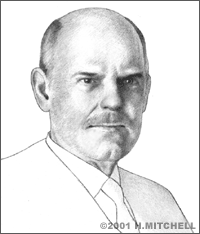Edward Acheson
Edward Goodrich Acheson (1856-1931), inventor of carborundum, was born in Washington, Pennsylvania on March 9, 1856. Carborandum, a substance he developed in his laboratory, became known as a highly effective abrasive used in manufacturing and was an important influence during the industrial era.
Acheson had been fascinated by engineering and mathematics as a child. When his father died, Acheson, still a teenager, was forced to go to work. He worked at various railroad jobs and performed experiments after hours. He became interested in the electrical field and decided to work for a manufacturer of electrical equipment. He first applied to Edward Weston, who made electroplating dynamos, but was turned down. But, at the age of 25, he was able to secure a position with Thomas Edison in his Menlo Park, New Jersey, laboratories.
In Edison's Lab, Acheson worked on the development and installation of electrical lighting, including working on the lamp exhibit at the Paris Exhibition in 1881. Edison himself had quickly recognized his inventive genius and made him an assistant chief engineer.
Acheson returned to New York in 1884 and became superintendent of a plant manufacturing lamps that competed with those invented by Edison. Acheson soon started doing experiments of his own. He first tried heating carbon to the point at which a diamond would result in an attempt to create a strong and durable industrial abrasive. This process failed, so Acheson began mixing clay with carbon and electrically fusing it. The product that resulted had several shiny specks that were hard enough to scratch glass. It was silicon carbide. However, because he at first mistakenly thought the crystals were a compound of carbon and alumina from the clay, he devised the trademark carborundum, after corundum, the mineral composed of fused alumina. In 1893, he received a patent on the substance.
Soon after Acheson came up with the process for creating carborandum, many realized that the mass production manufacturing of precision-ground, interchangeable metal parts would be practically impossible without the substance. The hardest surface made by man and second only to diamond in hardness, carborandum ended the search for a highly effective and durable abrasive that industry had so badly needed. Acheson established a manufacturing plant for carborundum in Monongohela, Pennsylvania, but demand for the product soon exceeded his ability to supply it, so he built a larger plant in 1895 in Niagara Falls.
Meanwhile, in the mid 1890s, Acheson discovered that overheating carborundum produced almost pure graphite. While studying the effects of high temperature on carborundum, he had found that silicon vaporizes at about 4,150° C (7,500° F), leaving behind graphitic carbon. This graphite was another major discovery for him, and it became extremely valuable and helpful as a lubricant. The Acheson Graphite Co. was formed in 1899. In 1928, this company merged with National Carbon Co., now Union Carbide. Acheson also developed a variety of colloidal graphite products including Oildag and Aquadag. These were later manufactured by the Acheson Colloids Co., now Acheson Industries.
Over the course of his career Acheson received a total of 70 patents relating to abrasives, graphite products, reduction of oxides, and refractories. Acheson received many honors and awards including the Perkin Medal and an honorary doctoral degree from the University of Pittsburgh. In 1928, he used his own funds to establish what is known as the Edward Goodrich Acheson Award. He was the first recipient of the award in 1929.
In 1908, the American Academy of Arts and Sciences awarded Dr. Acheson the Count Rumford Medal for his applications of heat in the electric furnace for industrial purposes. He was awarded the John Scott Medal by the Franklin Institute in 1894 for the invention of carborundum and in 1901 for the invention of artificial graphite. Dr. Acheson also received the Grand Prix at the Exposition Universelle Internationale, Paris in 1900, the Gold Medal at Pan-American Exposition of 1901 for artificial graphite, and the Grand Prize at the Louisiana Purchase Exposition in 1904 for carborundum and artificial graphite. He died on July 6, 1931.
Acheson Industries is now a part of Henkel Adhesives International, the Acheson brand being a leading worldwide provider of coatings, inks, and lubricants for various industries. Dr. Acheson’s grandson, Dr. James C. Acheson, ran the company after his own father’s death in 1975 for 20 years before he branched off and created Acheson Ventures, LLC, a land development company based in Port Huron, Michigan.


